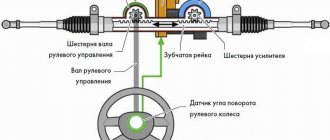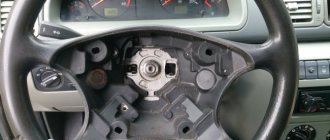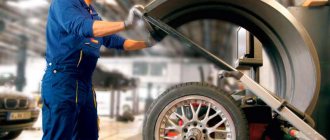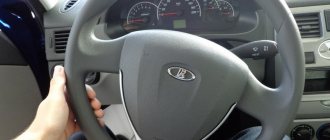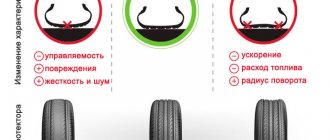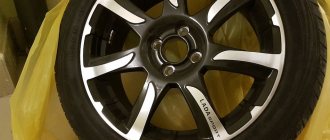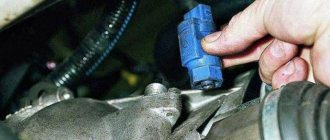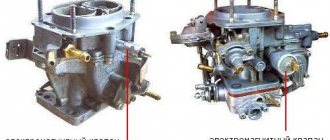Almost any driver can install a VAZ 2110 gearbox on a Granta. If you don't want to pay more for the original, this would be ideal for you. Any gearbox from front-wheel drive Ladas is suitable for the Granta.
Author of the article: Roman Krasinets 08/21/2020 0 0
When a gearbox on a Grant fails, the owner is faced with the problem of replacing it. He has to install either the original box, or think about converting the gearbox from a VAZ 2110 to a Grant. There is no particular difference or problems, and you will see this.
Steering wheel vibration: 35 reasons
Steering wheel vibration can occur for many reasons. Let's look at the main ways to identify and eliminate them.
Steering wheel vibration while driving
The causes of steering wheel vibration at low (20 – 30 – 40 km/h), medium (50 – 60 km/h) or high (100 – 110 – 120 km/h) speeds are:
- tire defects;
- wheel rim defects;
- errors during tire fitting, balancing and fastening of wheels;
- malfunction in the drive of the steered wheels;
- operational reasons and regulatory deviations;
- influence of external forces;
- wear or damage to parts that determine the geometry of the suspension, the position of the wheel, and the rigidity of its connection with the steering wheel.
Let us examine in detail the main root causes.
Vibration of the steering wheel at speed due to imbalance of the wheels (primarily the steering axle wheels) occurs due to the following primary reasons:
- incorrect wheel balancing in a tire service (random error or the result of low qualifications of the performer, malfunction of the balancing machine);
- disconnection of the balancing weight due to improper fastening or external influence;
- dirt or ice between the spokes of the disc or on the shelf (usually on the inside);
- uneven tread wear as a result of manufacturing defects or general low quality of the tire;
- uneven wear of the tire tread on one axle as a result of incorrect wheel alignment angles;
- getting into the tread of the tire and holding a massive foreign object (key, bolt, etc.);
- uneven circumferential loss of studs on studded winter tires;
- accumulation of rubber chips inside the tire on one side after driving with completely flat tires.
Steering wheel vibration at high speeds (100 – 110 – 120 km/h) most often occurs due to wheel imbalance.
Steering wheel vibration due to deviation from the correct geometric shape of the tire. It can be either irreversible or temporary. Temporarily this manifests itself in the following main cases:
- violation of the optimal order for storing wheels (both new ones, during delivery and storage before their purchase and initial installation, and used ones, during off-season storage);
- long-term parking in severe frost (a flat “shelf” is formed in the lower part, the “kneading” of which requires a run of several hundred meters to a couple of kilometers).
For these reasons, vibration of the steering wheel at speed begins almost from the very beginning of movement, but over time the tire “warms up” and returns to its normal shape, the vibration and noise disappear.
Deviation from the correct shape of the tire becomes irreversible as a result of the following reasons:
- internal tear of the tire cord due to external influence (for example, after hitting a curb, etc.), which over time, with continued operation, leads to the fact that the dynamic nature of steering wheel vibration is aggravated by imbalance due to intense uneven wear of the tread;
- uneven wear due to a factory defect in the tire that appears over time during normal use;
- incorrect alignment angles of the wheels (or one wheel), which causes a change in the balance of forces and also, over time, leads to local wear and loss of balance.
Shape deviation is detected by visual inspection of runout when the wheel rotates, and uneven wear is detected by measuring the tread height (groove depth) in several places along the diameter and width of the tire. A defective tire must be replaced.
Vibration of the steering wheel due to deviations in the geometry of the wheel rim is also possible in several cases:
- as a result of a strong impact of the wheel (on a curb, the edge of a hole in the road surface, during an accident, etc., which can also be further facilitated by insufficient tire pressure);
- due to the insufficient strength of the disc due to its poor quality, even with moderate dynamic movement on uneven surfaces;
- as a consequence of a rare manufacturing defect, in which the positioning planes of the disk in the standard mount on the car and behind the central hole in the balancing machine are different (after precise balancing, runout appears on the car).
Often, a change in the shape of a disk can be noticed visually both statically and during manual rotation of a raised wheel without removing it from the car, but a more reliable and accurate way is to check it at a service center. The method of eliminating the defect consists of rolling it on a special machine or replacing the disk with a new one, depending on the conclusion of competent specialists based on the results of the inspection in each specific case.
Steering wheel vibrations due to problems with wheel mounting and wheel fasteners can also have several root causes:
- loosening (unscrewing) the fasteners until a gap forms between the wheel disc and the contact plane of the brake disc/drum;
- discrepancy between the geometry of the fastener and the disk holes, in which the disk is unevenly positioned relative to the hub axis and is thus tightened during fastening;
- the entry of a foreign object (usually dirt) onto the contact plane under the disc, which also disrupts the correct positioning of the wheel when tightening the fastening.
Unfortunately, incomplete tightening of the fasteners is not so rare when rearranging the wheels yourself; this also happens in the service. In this regard, it is very reasonable for every driver to adopt a mandatory procedure for checking the tightening after installing the wheel, before starting to drive and after several kilometers of driving. You don’t have to do the inspection yourself - you can contact another employee or the nearest tire service.
Steering wheel vibration due to incorrect selection or installation of tires occurs as a result of the following situations:
- different tires on the same axle (for example, discrepancies in size or permissible load with the same size);
- incorrect setting of the direction of rotation of one of the wheels with a directional tread pattern.
These reasons are identified by visual inspection of the markings on the sidewall of the tire and careful comparison with similar data on the tire on the other side of the car. The following are subject to comparison:
- full name of the brand and model, including such name elements as the designation “SUV” (for crossovers), generation (“2”, etc.) and others;
- linear dimensions of the tire - width and height of the profile (for example, 225/50);
- load index (for example, 94, 97,...105, etc.);
- speed index (for example, U, H, V, W, etc.);
- direction of rotation, which is indicated by an arrow and the inscription “Rotation”);
- side for installation - external (inscription “Outside”) or internal (Inside);
- other markings (for example, XL or Extra Load - reinforced tire) may be indicated.
Steering wheel beating at speeds of 100-120 km/h: causes and solutions.
Reason No. 1 is improper operation of the car on poor-quality road surfaces: high-speed off-road driving, getting into holes (potholes) at speed.
Ways to eliminate it:
- repair of the disc in a specialized workshop using a rolling stand, followed by its (together with the tire) balancing;
- replacing the disk if it is not repairable (you can also replace it with a used disk that is in good condition).
Reason No. 2 - deformation of the outer part of the tire - the appearance of a “pear” on the rubber, its swelling.
There is only one way to eliminate it - replace the tire, since further use of deformed rubber is very dangerous.
Reason No. 3 - incorrect wheel balancing (imbalance), for example, due to balancing on a machine configured for a disk of a smaller radius.
The solution is to rebalance the wheels (here is an article about balancing wheels yourself).
Reason No. 4 is the loss of the balancing weight of the wheel rim during vehicle operation.
The solution is to re-balance.
Reason No. 5 - dirt sticking to the inside of the wheel rim when driving off-road, ice freezing on the wheel rim (for example, after visiting a car wash in winter) - everything that leads to wheel imbalance.
The solution is to clean the wheel from ice and dirt mechanically (remove the wheels, remove the ice and dirt with a brush) or by “thawing” the car in a warm garage (box).
Reason No. 6 - malfunction of the rubber-metal silent blocks of the steering arms of the front suspension.
There is only one solution - replacing the faulty part - a silent block or lever (read about replacing silent blocks with your own hands here).
Reason No. 7 - uneven tire wear (for example, during sudden braking). As a rule, it is most common in cars that are not equipped with an anti-lock braking system (ABS).
The solution is to replace the tire.
Reason No. 8 – curvature of the front brake discs due to a sharp temperature change (frequent braking, sudden entry into a puddle).
The solution is to replace the deformed spare part (about replacing brake discs here).
Reason #9 is the use of low-quality rubber.
Remedy: replace/return the rubber to the seller during the warranty period.
Thus, when answering the question of what “threatens” the steering wheel beating at a speed of 100-120, it is important to remember that any car requires proper and timely care. So, if you notice the first signs of a malfunction, immediately begin to fix it, and do not wait for this malfunction to result in other problems.
Tire imbalance
The reason for this phenomenon may also be defects in the rubber itself as a result of hitting an obstacle or falling into a hole (often at high speed), which causes the carcass elements on the tire to deteriorate and it takes on an irregular shape. This defect is called a “hernia.” It is almost impossible to correct it, but you can try to correct it by balancing the wheel. But even in this case, the steering wheel will vibrate at speeds of 90-100. What to do in this situation? Such a tire will still no longer work as it should, and it will soon have to be changed.
Balancing required
How to make and install a heated steering wheel
Runout on the steering wheel and car body with increasing speed is inevitable if the wheels are not balanced. The uneven distribution of mass relative to the center of the wheel rim leads to such consequences. The action of multidirectional centrifugal forces leads to the appearance of multi-frequency oscillations, which are felt as a beating in the car interior.
The problem may manifest itself in the following cases:
- Installing new tires. Replacing tires on rims or putting new rims on old tires must be accompanied by balancing. Even for the manufacturer, achieving ideal weight distribution and geometric parameters seems to be an extremely difficult task.
- Loss of old balancing weights. This is especially true for light alloy wheels, where the weights are glued to the inside of the wheel. Let us remember that in the case of stamped rims, the weights are placed in the outer shoulder of the rim.
- Deformation of the rubber or disk due to falling into a deep pothole, a strong impact with the curb and other similar obstacles.
- Natural imbalance. During operation, any wheel will lose its established balance. It is recommended to carry out scheduled balancing every 15-20 thousand km.
CV joint
Another breeding ground for imbalance is often the constant velocity joint. It serves as a device for the movable articulation of the drive shaft and gearbox, which allows the transmission of torque in different planes (internal CV joint). At the other end of the drive shaft for articulation with the hub (outer CV joint).
Most often, the cause of vibrations lies precisely in the internal hinge. In the case of a tripod-type design, wear out of the rollers is observed. In especially severe cases, the bearing may even “fall apart”. It is also possible to produce a tripod glass.
A similar malfunction can be caused by a torn boot, which can no longer protect against dirt and dust flying from under the wheels. Therefore, periodically check the integrity of the CV joint boots.
Drive shaft
It will be worth mentioning that a car with a drive of irregular geometric shape is guaranteed to experience vibration when accelerating. A bent drive shaft will not only rotate around its axis, but also provoke parasitic centrifugal forces. As a result, the car will receive additional vibrations as it accelerates.
Cardan
The problem is typical for cars with rear-wheel drive and all-wheel drive. Wear of the cardan joint leads to vibration during acceleration.
If you encounter a similar problem, pay attention to the following elements:
- crosses;
- suspension bearing;
- directly to the driveshaft. An unbalanced cardan will lead not only to beating, but also to subsequent destruction of the joints.
There were cases when the cause of runout at speed was play in the gearbox shank
This also needs to be paid attention to.
Wheel bearing wear
This element ensures smooth rotation of the wheel on the axle. Its long-term operation is ensured by the correct tightening torque, at which it should rotate freely, but without play. An undertightened bearing, like an overtightened one, quickly wears out and begins to jam. This is quite easy to check. With the wheel removed, you need to release the pads and turn the brake disc by hand. If, when the latter rotates, the resistance to rotation increases from time to time and an extraneous sound appears, it means that the bearing is jammed. It should also disappear when the nut holding the bearing is slightly loosened. It won't last long in this condition.
Diagnostics and standard causes of vibrations
VAZ 2110 vibration on the steering wheel
There may be several reasons why vibrations are observed on the steering wheel of a VAZ 2110 car. In many cases, a superficial diagnosis will not provide accurate answers, and only a competent, thorough examination will help determine an accurate diagnosis.
Brake pads
As a rule, new motorists who understand little about cars naively believe that shaking and vibration are the result of worn brake pads. Having installed new brake pads, motorists begin to understand that the reasons lie much deeper. Although, if this “disease” has not gone too far, then changing the pads also helps, but for a while. And for the most part, replacing pads with new ones is a waste of time and effort.
Discs
As for the so-called “garage” specialists, they will all say the same thing - vibrations are associated with brake discs that need to be replaced with new ones. And it is imperative to install imported brake discs, since domestic ones do not cope well with their function. What's true is true. The runout of domestic brake discs installed on a car is much greater than even that of old discs installed on an assembly line. In addition, the metal of our discs is often “raw,” so to speak, that is, it is easily affected by the brake pads and wears off.
Note. Installing new brake discs does not completely guarantee that vibrations will disappear. The fact is that the reason may lie even deeper, and changing disks will only give half the effect.
Grooving brake discs
Grooving brake discs
Usually, when a car runs more than 50 thousand km, complaints about steering wheel shaking increase. The standard diagnostic option in service centers is as follows:
- The chassis of the car is carefully checked;
- The vehicle controls are subject to diagnostics;
- The left steering tip is often replaced;
- Wheels are being balanced;
- Brake discs are either replaced with new ones or sharpened.
The question arises: why buy new brake discs, especially ventilated ones (they are not cheap), if you can simply grind them, which gives excellent results.
Attention! It is noteworthy that sharpening brake discs is not so easy. This requires the skills of a highly qualified turner, who can identify by eye the excess part of the working surfaces, which he can successfully grind off. After this, the surfaces may remain rough, but there is no need to worry about this.
Attention! The minimum permissible thickness of a ventilated disc for a VAZ 2110 is 17.8 mm, and a non-ventilated one is 10.8 mm.
Non-standard reasons
It’s interesting, but it also happens that after sharpening and installing the discs, the vibrations on the steering wheel do not disappear. In this case, an unconventional method can help - turning the hub itself on a lathe, which reduces runout.
Wheels do not comply with factory recommendations
A car rim has its own parameters - width, tire mounting diameter, offset, as well as the diameter of the drill, i.e. the circle on which holes are drilled for mounting bolts or studs. For each wheel model, the number of these holes and their diameter are indicated. If the disk parameters are incorrectly selected, the mount will not screw in completely and will not press the wheel tightly to the hub. As a result, the disk has play. If the diameter of the holes drilled does not match, the wheel will also not sit in its place. Of course, it can be planted using physical force. However, the plane of the disk will not coincide with the parameters of the hub. This is not good for the car.
Tire quality problems
photo: Ildar Garifullin / unsplash.com
Tire sellers admit that quality defects affect not only low-cost tires, and problems with wheel balancing affect not only large-diameter wheels. Moreover, some particularly expensive tires require not only professional, but also high-quality equipment to install the tire on the rim. Such equipment can rarely be found in car services in Germany and England.
Therefore, take car maintenance very seriously, including high-quality tire fitting, if you have purchased an expensive car or an exclusive set of wheels with expensive sports tires.
Worn or warped brake discs
These elements are installed on the hub and are clamped by pads when the speed decreases. There is practically no gap between the disc and pads. Therefore, the surface of the assembly must be perfectly flat. The slightest distortion of the disc causes the steering wheel to vibrate at speeds of 90-100 km/h. Warping of brake elements most often occurs due to frequent and intense braking, as well as when driving through deep puddles. The heated disk bends due to sudden cooling. This element cannot be repaired - only replaced.
Summary
If you study the malfunctions, you can derive a small rating of the prevalence of causes. So, if the steering wheel of a VAZ-2114 shakes at low speed, then in the first place are problems with the integrity of the tires and rims. For many, vibrations were caused by a hernia or a crooked wheel. Then there are breakdowns in the suspension and steering mechanism. But often the problem can be solved by a simple visit to a tire shop. And to eliminate this situation, you should brake well before each large hole and be careful when passing railway tracks. A bump on the sidewall of a tire cannot be restored.
Post Views: 2
What should you do if your steering wheel vibrates?
First of all, you need to understand that this malfunction occurs at a certain speed. Accordingly, first of all, you need to determine how fast the car moves when vibrations occur.
After all, vibration on the steering wheel, at a speed of 100 kilometers or less, or when braking, can be caused by completely different reasons. Most often, the runout is clearly noticeable at medium or low speeds, subsides at high speeds, and appears again at higher acceleration.
A serious feature is that a slight beat is felt only at high speed.
Steering wheel shakes when braking
Steering wheel wobble when braking is a common reason why car enthusiasts turn to service stations, where they begin to “spin” them by inventing non-existent problems. The following reasons can be identified for the steering wheel wobbling during heavy braking:
- unbalanced wheels (solved by ordinary balancing);
- broken wheel bearing (the wheel can wobble noticeably and bounce into the steering wheel when braking);
- worn brake pads (5 minutes + basic DIY skills and brake pads replaced).
Most of the problems listed above can be solved in your own garage, if you have a jack and new pads (bearings), you will have to tinker with replacing the wheel bearing. It is worth choosing new spare parts especially carefully, especially for AvtoVAZ spare parts, which do not differ in quality, even original and new ones. The wheels can be balanced within 20-40 minutes at the nearest tire shop.
The steering mechanism is a single system; a breakdown of the mechanism will certainly lead to a breakdown of the interconnected element; if the steering wheel shakes when braking, it is worth conducting a comprehensive diagnosis of the vehicle's control systems and checking its suspension.
If the steering wheel hits hard when braking at high speed and pushes into the brake pedal, then the reason for the steering wheel beating is in the brake discs, which have become deformed and become unusable. This can be temporarily corrected by vigorous sanding. If possible, purchase new ones; it is better to take imported brake discs.
What to do to eliminate steering wheel vibration
Balancing due to dirt
One of the most common causes of steering wheel wobble when driving is dirty discs, which can get covered with snow and dirt. This problem most often occurs among those drivers who drive a lot off-road, or on poor roads. Accordingly, first of all, you need to check how clean your disks are.
If the car has alloy wheels, then detecting dirt will not be a problem. It's a little more difficult with steel wheels, which have small ventilation holes, as well as special caps that are supposed to improve the exterior. Accordingly, it is somewhat more difficult to detect contamination.
The only option for troubleshooting in this case is to completely clean the wheels.
Balance imbalance due to the shape of the rims
As you know, tires and rims are made imperfect in shape and composition, which leads to different weights in different areas. This leads to a shift in the center of gravity of the wheels, which can be either almost imperceptible or very noticeable. An imperfection in the wheel can cause a shift in the centrifugal force, which in turn causes the steering wheel to vibrate when moving.
In addition to causing the steering wheel to wobble, improper wheel balancing can cause excessive wear on the tires in some areas, as well as on the suspension components and wheel bearing.
If the wheels are out of balance, it causes the steering wheel to vibrate when driving at speeds above 60 kilometers per hour. In order to eliminate it, you must first check the evenness of the tires, as well as the absence of damage and dents on the rims. If nothing is found as a result of the check, then it is necessary to balance the wheels.
Deformation of tires or wheels
Quite often the steering wheel vibrates at speed due to deformation of tires or rims. Most often, such damage is caused by falling into a hole, or simply while the car is moving.
Therefore, to identify the problem, you need to carefully inspect the wheels, check the rim and the inner surface of the disk, which is most often deformed. It is also very important to check the condition of the tires. The degree of damage to tires or rims can be indicated by the speed at which vibration occurs in the steering wheel. The lower the speed, the more damage.
In case of such damage, the only option is to replace the wheels and tires.
Insufficient tire pressure
Low pressure in the tires of a car rarely causes the steering wheel to wobble, but often leads to vibration of the entire car. The only way out of this situation can only be to inflate the tires.
Poor wheel alignment
This situation is extremely dangerous, since an improperly secured wheel can fly off at any time while driving, causing a serious accident. If the problem is not identified and corrected in time, then in addition to vibration of the steering wheel at speed and during braking, damage to the brake discs, wheels, and hub may occur over time.
In such cases, the beating of the steering wheel is felt even at low speed or at the start of the movement. The vibration will be acyclic and can occur at different speeds.
In order to eliminate vibration, simply tighten all the nuts and bolts in the wheels well. However, in some cases, damaged parts will need to be replaced.
Damage to the suspension or steering system
Any car enthusiast knows that the condition of the suspension directly affects the contact of the car with the road surface. Accordingly, play in the suspension can cause various vibrations when driving.
However, it must be remembered that play in the suspension cannot be the direct cause of vibrations and beating of the steering wheel. Insufficiently fastened elements simply allow weak vibrations from the wheels to appear. Accordingly, the main reason will still be damage to the wheels or tires.
If a beating in the steering wheel occurs when driving on an uneven road, this indicates damage to the steering rack. Most often, the bushing fails, and repairs must begin with this part.
In addition, a faulty shock absorber can cause similar problems.
Beating and vibration when braking
In cases where steering wheel vibration occurs during braking, most likely the cause of the problem lies in a malfunction of the brake drums or discs. That is, their working surface is not perfectly round.
These elements can change their shape as a result of damage from impact, overheating, improper braking, or simple wear and tear during operation. A fairly common reason for changes in the shape of brake discs is intense heating due to prolonged cooling followed by contact with water or snow, which causes sudden cooling. The only option to eliminate such a malfunction is to replace the brake discs and drums. You can buy these spare parts on the Internet, brake discs and/or drums for Jeeps, for example, here Avtozapchasti24.lv
The occurrence of beating and vibrations when cornering
Vibrations in the steering wheel when turning, as a rule, indicate that the silent blocks or constant velocity joints have failed. If the joints fail, you can hear a characteristic crunch while turning. Therefore, during repairs, it is necessary to check the wheel bearings. In order to prevent malfunction of the chassis system, it is necessary to regularly inspect all parts.
One of the early signs of such a problem may be the cracking of the anthers, as well as the appearance of cracks in them. In this case, the anthers need to be replaced.
If sand or dirt gets into the anthers, they must be cleaned with a gasoline solution.
Mismatch between the dimensions of the hub and the central hole of the wheel
Quite often, when replacing wheels, drivers do not purchase original parts, but cheaper analogues. Unfortunately, the central hole in the wheel is often larger than the diameter of the hub, which means the disc will not fit tightly.
The effect of such a disadvantage may only appear under load, and may not occur at low speeds. In order to eliminate vibration and beating of the steering wheel in this case, you can try using special gaskets, or simply replace the wheels.
Causes of steering wheel beating when braking
- The brake pads are worn to zero;
- Lamination of pads;
- Development of the brake disc;
- Violation of the geometry of the disc or brake drum;
- Work disrupted
Vibration in the steering wheel, brake pedal or throughout the car can begin for a number of different reasons, such as burst engine mount brackets, bent wheel rims, poorly balanced wheels, worn CV joints and a number of other reasons. But none of these car problems would cause vibration in the steering wheel only when braking. Vibration or shaking of the steering wheel when braking on disc brakes is almost always only due to deformed brake discs.
The steering wheel, brake pedal, or vibration due to deformation of the brake discs
First of all, what is a brake disc? It is also called a brake rotor. This is that part of your car's chassis system that rotates with the wheel (the wheel is directly attached to the brake disc) and which is clamped by the brake pads when you want to stop the car. In other words, the brake disc is a very important part of the car.
In the picture, an auto mechanic is pressing real brake pads onto a brake rotor. In fact, this work is done by the caliper
Why the deformation of the brake disc may cause vibration or beating on the steering wheel is easier to find out by understanding the principle of operation of the disc. Brake rotors are typically made of metal and come in a specific width depending on the make and model of your car. When applying the brakes, the pads are strongly pressed against the disc, creating enormous pressure and frictional force, causing the brake disc to become very hot. This heating provokes a slight change in the density of the metal of the disk, and this disk should cool evenly over its entire surface. However, this does not always happen, and when a brake disc cools suddenly and unevenly, it tends to warp in certain areas. This deformation takes on a wavy shape. It turns out that when brake pads clamp a deformed disc at high speeds, this disc causes the entire caliper to vibrate left and right, and with it the entire wheel, transmitting vibration to the steering wheel or the entire car.
How exactly an overheated brake disc is cooled sharply, we think, is not necessary to say. Note that the reason for this may be a puddle or snow after prolonged braking.
When the disk is deformed in this way, they say “the disk has led.” Since this happens after the brake disc overheats, usually the second symptom, if the reason that the steering wheel is shaking or vibration appears, is precisely the deformation of the disc - this is a bluish tint, which also appears due to overheating.
If you have the first suspect, then you can check the disk deformation quite simply - lift the suspected wheel on a jack so that it rotates freely (and is not blocked by either the brake or the gearbox - just so that the car does not roll). Next, spin the wheel by weight - it should spin freely. If the wheel rotates normally and easily for part of the described circle, and then stops or slows down significantly, moreover, at the same point, then, most likely, the brake rotor on this wheel has spun.
You can more reliably check whether the brake disc is vibrating in front or behind you by braking with the handbrake - if vibration also appears during such braking, then most likely the reason is in one of the rear rotors.
If the brake disc on the front wheels starts to slip, you will feel that it is the steering wheel that is hitting the steering wheel when braking. And if it’s on one of the rear wheels, then you may not notice the vibration at all, although in cases where the disc has moved quite strongly, the vibration during braking is noticeable at high speeds. But the vibration of the brake pedal will not reliably show which of the rotors has started.
What to do? The reason that the disc started to slip may not be the fact of hypothermia itself, although if you drove down a hill with the brakes on for a long time, and then drove into a puddle or drove through loose snow, then this case can be called the reason. But often it is overheating of the brake disc, and not its cooling, that causes deformation. And it overheats due to a jammed caliper - when the pads are constantly pressed against the disc, preventing the wheel from spinning freely and causing excessive heating. And in this case, it is necessary to eliminate the root cause of overheating.
If the brake disc fails, it can be replaced. It is quite expensive - depending on the car model, the price of a brake disc can range from 2 to 10-15 thousand rubles. But you can also bore it - this is a fairly simple procedure that is carried out in car services, without even removing it from the car. Boring consists of grinding the waves down to a completely flat surface of the disk.
Brake disc boring work
But on drum brakes, drums, similar to the rotor on disc brakes, are rarely deformed due to overheating or hypothermia after overheating.
Steering wheel shakes or vibrates after replacing a brake disc, hub or wheel bearing
But if the beating on the steering wheel or throughout the car was preceded by service work on the chassis of the car, then the root cause should be looked for first here. Most often, vibration when braking can appear after replacing the brake disc, hub or wheel bearing. And the specific cause of vibration and beating can be not only in these defective parts (although more often in them), but also in poor quality work. The brake rotor may have been tightened incorrectly, over-tightened, or not tightened crosswise. The torque to which the brake rotor must be tightened is usually indicated on the disc itself.
If vibration of the steering wheel during braking or the entire car appeared precisely after any work carried out on the chassis, then contact the same mechanic who carried out this work with the problem.
Steering wheel shaking or vibration due to a cracked brake disc or drum
Perhaps the worst thing that can cause vibration is a cracked brake disc or drum in drum brakes. This usually also happens due to overheating or strong mechanical stress on them. Usually this happens rarely and only on worn (thinned) brake rotors or rusted drums.
Crack on the brake disc
Could the vibration be caused by the pads?
Despite the fact that low-quality or worn pads appear quite often as a possible root cause of vibration on a car or beating on the steering wheel, in our opinion, they cannot in any way cause vibration on the steering wheel or the entire car when braking. This is not a moving part and there cannot be cyclical operation in it, therefore, with a smooth brake disc, the pads and caliper cannot cause such vibration.
What else can cause beating or vibration when braking, but quite rarely:
- problems in the steering rack or worn out ball joints in the chassis;
- worn and improperly functioning shock absorbers (here vibration appears more often when turning in the direction opposite to the side with a worn shock absorber);
- worn or rotted shock absorber strut mounts;
- strong side impacts on curbs during accidents, etc. (usually deformation of the brake system is preceded by deformation of the wheel disc);
- steering tips.
Is it possible to ignore the vibration and beating of the steering wheel when braking, if it does not interfere much?
If your steering wheel shakes when braking or the whole car vibrates, then it is still better to contact a mechanic. But the problem can be ignored for some time - months or even years. But you need to keep in mind that if the problem is caused by improperly tightening the nuts, then it can be quite dangerous. In addition, vibration of the discs puts an increased load on other elements of the chassis - the same hub, shock absorbers, steering system, and this is more serious and expensive.
But vibration on the steering wheel when braking at high speed is also unsafe. In fact, you can easily lose control of your car if the vibration is strong enough. Driving is already one of the most dangerous things we do every day, so saving money on fixing a wobble in your steering wheel shouldn't be a reason to increase that danger. Plus, very few of us can avoid looking funny while gripping a shaky steering wheel—remember that when you're driving your girlfriend on a first date or just giving a ride to a stranger. Believe me, a strongly vibrating steering wheel and no less strongly vibrating hands on it are very noticeable from the outside.
During the operation of the car, many malfunctions are revealed. One of the most common is the steering wheel shaking when braking or in some speed range. There may be many reasons, but the most important task is to identify the real one. One diagnosis is a beating of the steering wheel, and the fault can be hidden either in the brake discs or pads or in the car’s suspension.
The first thing you need to do is check the wheel balancing. Also visually check the tires for bumps. Adjust wheel alignment. But, before carrying out this procedure, you need to go through the entire suspension. The fact that mechanics at a service station will not undertake to do a wheel alignment on a car with a broken suspension is correct.
Firstly, for the master himself this procedure will be too labor-intensive. Secondly, it will bring positive results for you in the short term. Thus, the steering wheel vibration will disappear, but not for long.
Completely assess the condition of your car’s suspension and steering rods. There are often cases where worn ball joints cause the steering wheel to wobble when braking or in the speed range. If all the suspension components in a car have become unusable, then everything needs to be sorted out, all worn parts replaced with new ones.
